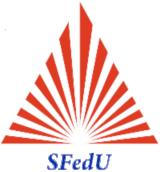Valentin Vladimirovich Bakhchevnikov
Research interests:
The scientific researches are in the field of radiophysical methods of remote sensing of terrestrial and water surfaces, the theory of electromagnetic scattering of radio wave, functional processing of radio signals of radar systems and applying algorithms of digital signal processing onto FPGA.
Has more than 20 scientific papers.
LIST OF BASIC SCIENTIFIC AND EDUCATIONAL-METHODOLOGICAL PUBLICATIONS OF RECENT YEARS:
1. V. V. Bahchevnikov. Imitacionnaya model' otrazheniya radiosignala sloistoj poverhnost'yu s neodnorodnostyami //Izvestiya YUzhnogo federal'nogo universiteta. Tekhnicheskie nauki. ; 2018, N. 7, p.155-166.
2. V. V. Bahchevnikov. Gibridnaya elektrodinamicheskaya model' rasseyaniya radiosignala na dvuhslojnoj strukture //Izvestiya YUzhnogo federal'nogo universiteta. Tekhnicheskie nauki. ; 2019, N. 2, p.79-90.
3. Bahchevnikov V. V. Imitacionnaya model' radiolokacionnogo signala KV diapazona, rasseyannogo sloistoj strukturoj s neodnorodnostyami//sbornik statej po rezul'tatam Mezhdunarodnoj konferencii molodyh uchenyh stran BRIKS "Sotrudnichestvo stran BRIKS dlya ustojchivogo razvitiya". - 2015. Tom 2. p.30-34.
4. Bahchevnikov V.V., Potipak M.V., Lobach V.T., Modelirovanie signala, otrazhennogo ot monohromaticheskoj poverhnosti. Prilozhenie OpenCL //tezisy v sbornike: Nauka v sovremennom informacionnom obshchestve Materialy V mezhdunarodnoj nauchno-prakticheskoj konferencii. North Charleston, SC, USA, 2015. p. 134.
5. Lobach V.T., Potipak M.V., Bahchevnikov V.V. Primenenie mnogochastotnogo radiosignala dlya zondirovaniya podpoverhnostnyh ob"ektov. //Materialy 26-oj Mezhdunarodnoj Krymskoj konferencii "SVCH Tekhnika i telekommunikacionnye tekhnologii" KryMiKo'2016 Sevastopol'. 2016. p. 2432-2438.
6. Bahchevnikov V.V. Modelirovanie harakteristik rasseyaniya radiosignala na sloistoj strukture // Materialy 25-oj vserossijskoj nauchnoj konferencii studentov-fizikov i molodyh uchenyh (VNKSF-25). Simferopol', 2019. p. 378-380.
7. Bahchevnikov V.V. Elektrodinamicheskaya model' radiosignala, rasseyannogo na mnogoslojnoj strukture, s ispol'zovaniem fizicheskoj optiki i metoda trassirovki luchej. Izvestiya vysshih uchebnyh zavedenij Rossii. Radioelektronika. 2019;22(6):25-36. https://doi.org/10.32603/1993-8985-2019-22-6-25-36
8. Bahchevnikov V.V, Derkachev V.A., Bakumenko A.N. Sposob ispol'zovaniya sredstv bystrogo prototipirovaniya dlya realizacii svertochnoj nejronnoj seti na PLIS //Izvestiya YUFU. Tekhnicheskie nauki. ; 2020. ; N. 3 (213). ; p. 146-156.
9. A. Bakumenko, V. Bakhchevnikov, V. Derkachev, A. Kovalev, V. Lobach, M. Potipak. Crop seed classification based on a real-time convolutional neural network //SPIE Future Sensing Technologies. ; International Society for Optics and Photonics, 2020. ; Т. 11525. ; С. 115252V.
10. RUKOVODSTVO I METODICHESKIE UKAZANIYA K LABORATORNYM RABOTAM PO KURSU "CIFROVYE USTROJSTVALobach V.T., Usenko O.A., Bahchevnikov V.V.Uchebno-metodicheskoe posobie / Rostov-na-Donu; Taganrog, 2020.
11. Derkachev V. A., Bahchevnikov V. V., Bakumenko A. N. KLASSIFIKATOR IZOBRAZHENIJ SEMYAN SEL'SKOHOZYAJSTVENNYH KUL'TUR S ISPOL'ZOVANIEM SVERTOCHNOJ NEJRONNOJ SETI //Izvestiya YUzhnogo federal'nogo universiteta. Tekhnicheskie nauki. ; 2020. ; N. 4 (214).
12. Bakhchevnikov V. V. Express Analysis of the Subsurface Irregularities from UAV //2021 Radiation and Scattering of Electromagnetic Waves (RSEMW). ; IEEE, 2021. ; С. 439-442.
Research projects:
Model researches of subsurface imaging for burried irregularities. Development of the HF radar for soil moisture measure.
Teaching:
-
Computer-aided design of electronic systems
This course introduces students into the overall process of computer aided design of electronic equipment and systems. Course description: Electronic equipment development and life cycle. Printed circuit board (PCB) fabrication and surface mount technologies. Technical documentation. Introduction to Altium Designer. Schematic entry, schematic library component management, electrical rule check and netlist generation. Circuit analysis and simulation. Board level design: PCB design rules, computer aided board design, mechanical design, preparation of manufacturing documentation. Design recommendations for circuits and equipment with special requirements.
-
SoC-FPGA Design
The development of embedded systems based on chips containing one or more microprocessors and hardcore peripherals, as well as an FPGA part is becoming more and more important. This technology gives the designer a lot of freedom and powerful abilities. Classical design flows with microcontrollers are emphasized with the full power of FPGAs.
-
Radar Systems Engineering
This course will describe the system-engineering process for analyzing project requirements and will provide insight into methods for requirements allocation and flow-down to radar front-end and back-end subsystems. In addition, you will be introduced to the design process for building modular and open-architecture radar systems and for designing robust, open, and maintainable front-end and back-end interfaces.
-
Digital Devices
This course explores the theory and principles of electronic devices and digital circuits. Special attention is devoted to topics related to logic gates, flip-flops, encoders, decoders, advanced digital systems, power switching and control. Laboratory experiments reinforce lecture theory and provide the student with experience in the use of test instruments and procedures.
-
Radar technology and radio navigation systems
The goal of the program is to prepare highly qualified personnel for scientific research who will be able to improve the existing and develop the fundamentally new radio systems. Areas of activity are: development of electronic equipment for aviation and space; creation of electronic components for defense and security; security systems; research of new types of complex signals for radar technology, radio navigation, and telecommunications with a higher level of informat...

